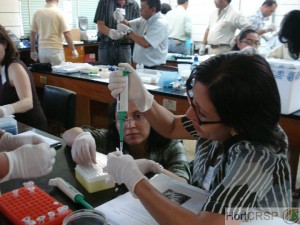New Network of Plant Pathologists Prevents Disease Spread
Phytophthora, Greek for plant‐destroyer, is a ubiquitous plant pathogen that robs the world’s farmers of billions of dollars each year. This soil‐inhabiting pathogen, more closely related to brown algae than true fungi, travels the dank, dirty corners of Earth’s underbelly using numerous aliases along the way, such as: root rot, sudden oak death, and late blight of potato. The last of these was responsible for the Irish potato famine in the 1850’s, which caused the death or displacement of over two‐million people. Other species of Phytophthora cause major losses to tomato, soybean, pepper, ornamental and forest tree species.
Growers and plant pathologists in the United States control the spread of Phytophthora through early identification, using a variety of diagnostic tools that enable them to act before the disease damages entire fields. The pathogen spreads via infected plant materials, historically crossing continents through tubers and nursery plants. However, farmers in the developing world have fewer resources to protect their fruit, vegetable and ornamental crops from Phytophthora, which thrives in moist environments prevalent in the humid tropics.
Early identification is the key to managing Phytophthora. Horticulture CRSP researchers are helping Central American farmers identify Phytophthora quickly and cheaply by building local scientific and technical capacity within their agricultural support system. The rapid and inexpensive diagnostic tools use morphological characteristics, molecular tools and a computerized key developed by Jean Beagle Ristaino at North Carolina State University to identify species of the pathogen (available here).
As a result of the training, laboratories in the region have been linked to create the Latin American Phytophthora Diagnostic Network (LAPDN). Defense efforts can now be coordinated across national borders, and clinics can work together to avoid exporting infected crops to North America and the rest of the world.
Researchers with the LADPN also surveyed at least 53 farms in Honduras and Costa Rica that grow potato, cacao, pineapple and tuber crops. These surveys allow scientists to identify disease trends on crops throughout the region that may allow for prevention of future outbreaks.
Central Americans from government regulatory agencies, private companies and public and private universities now employ state‐ of‐the‐art diagnostic technologies and have built a scientific network in order to help rural farmers manage this plant pathogen before it impacts their bottom line.
A version of this article, written by Elana Peach-Fine, originally appeared in the Horticulture CRSP newsletter. To view a video on this project please click here.

